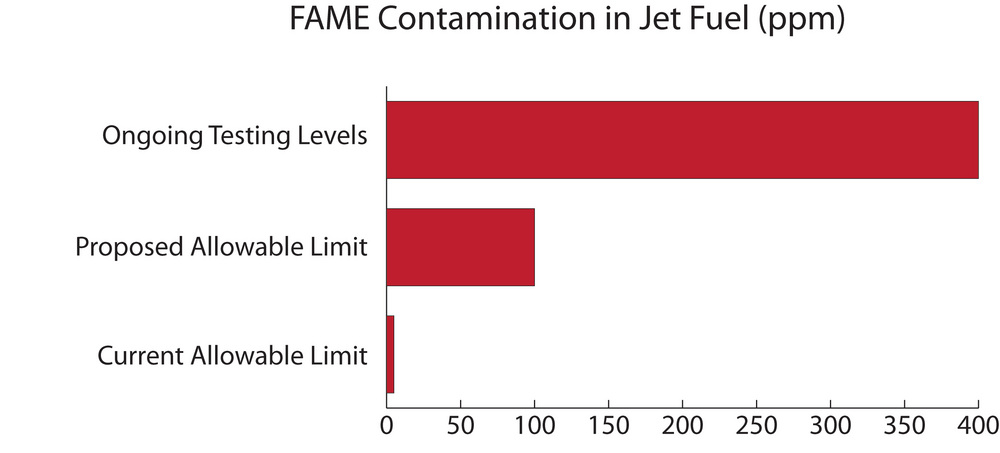Researchers develop 5 ppm FAME detector for jet fuel

August 26, 2013
BY Ron Kotrba
Millions of dollars and years of testing have already been invested in the attempt to increase ASTM’s allowable amount of fatty acid methyl ester (FAME) contamination in jet fuel, which can occur from pipeline movement of diesel containing low-level biodiesel blends followed by jet fuel. At high concentrations, biodiesel contamination in jet fuel may impact the thermal stability of the fuel, leading to coke deposits in the fuel system. Contamination can also impact the freezing point of jet fuel, resulting in gelling. Such conditions may result in engine operability problems and possible engine flameout. The current amount of biodiesel contamination allowed in ASTM D1655, the jet fuel spec, is up to 5 parts per million (ppm), a level so low that traditional analytical equipment such as gas chromatography, Fourier transform infrared and high-performance liquid chromatography cannot detect it.
“Allowing a higher level of biodiesel in the ASTM specifications for jet fuel than 5 ppm will make it much easier for pipelines to manage shipments of biodiesel blends in a manner that ensures jet fuel will always meet the specifications,” says Steve Howell, senior technical advisor with the National Biodiesel Board. The U.K.-based Energy Institute is leading a large consortium of interested parties to conduct testing (at 400 ppm, or four times the proposed allowable limit) needed by jet engine OEMs, the Airframe OEMs and the U.S. Federal Aviation Administration to support up to 100 ppm biodiesel contamination in jet fuel.
Advertisement
Advertisement
The report, to be published soon, will be reviewed and used to help determine the path forward at ASTM. While those involved wait, researchers at the University of Tennessee have developed thin-film sensors with high sensitivity toward biodiesel contamination in jet fuel. Small strips of these sensors have been tested to detect the trace biodiesel contaminant in diesel at as low as 0.5 ppm in less than 30 minutes. The sensor also gives quick response to B20 in less than five minutes and may be used with the naked eye. The sensors, developed by UT chemistry professor Ziling Xue and doctoral student Jonathan Fong, are intrinsically small, easy to use, inexpensive, and can be mass-produced for disposable applications. When combined with a portable reader, the sensors can be used as a compact portable device for field applications. The university is seeking partners to commercialize the technology.
Advertisement
Advertisement
Related Stories
Bangkok Airways Public Company Limited has officially announced the adoption of sustainable aviation fuel (SAF) on its commercial flights, reinforcing Thailand’s green aviation industry. The initiative took effect starting July 1, 2025.
Global digital shipbuilder Incat Crowther announced on June 11 the company has been commissioned by Los Angeles operator Catalina Express to design a new low-emission, renewable diesel-powered passenger ferry.
ATR and French SAF aggregator ATOBA Energy on June 19 signed a memorandum of understanding (MOU) to explore ways to facilitate and accelerate sustainable aviation fuel (SAF) adoption for ATR operators.
Argent Fuels, a leading provider of carbon-saving fuels in the UK, is accelerating its efforts to support a greener future. The expansion of its High Blend Biodiesel will supply to bus, coach, HGV fleets and rail in the south of the UK.
Sprague Operating Resources LLC on June 24 announced it has been selected by the New York City Department of Citywide Administrative Services to supply renewable diesel for its marine fleet, including the iconic Staten Island Ferry.
Upcoming Events










